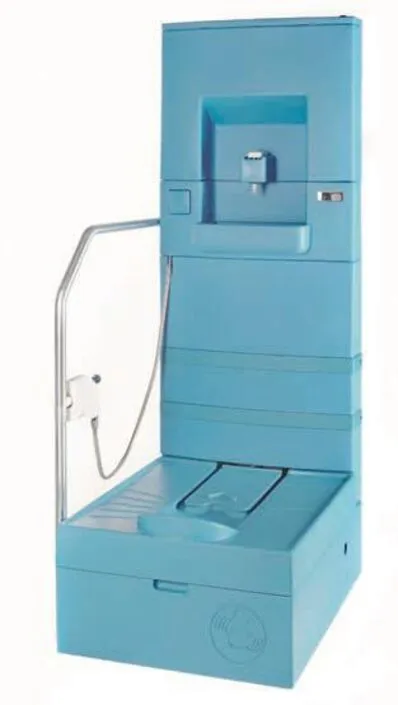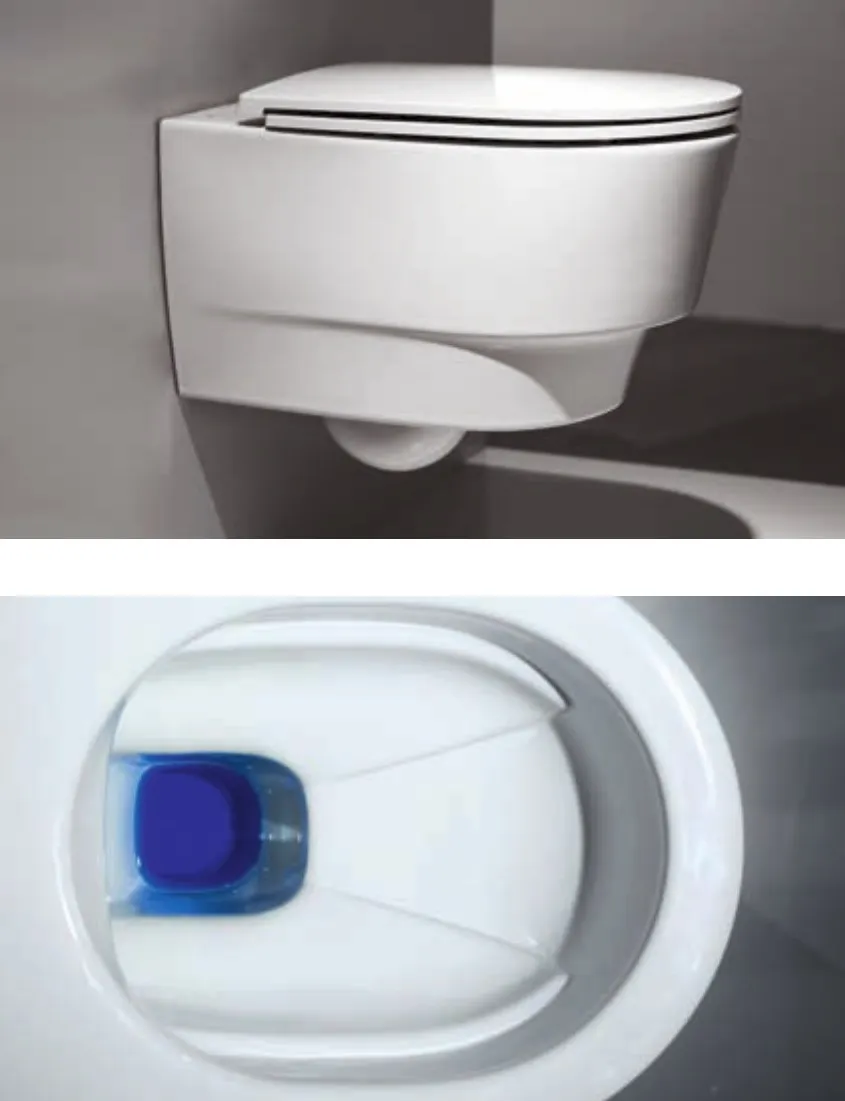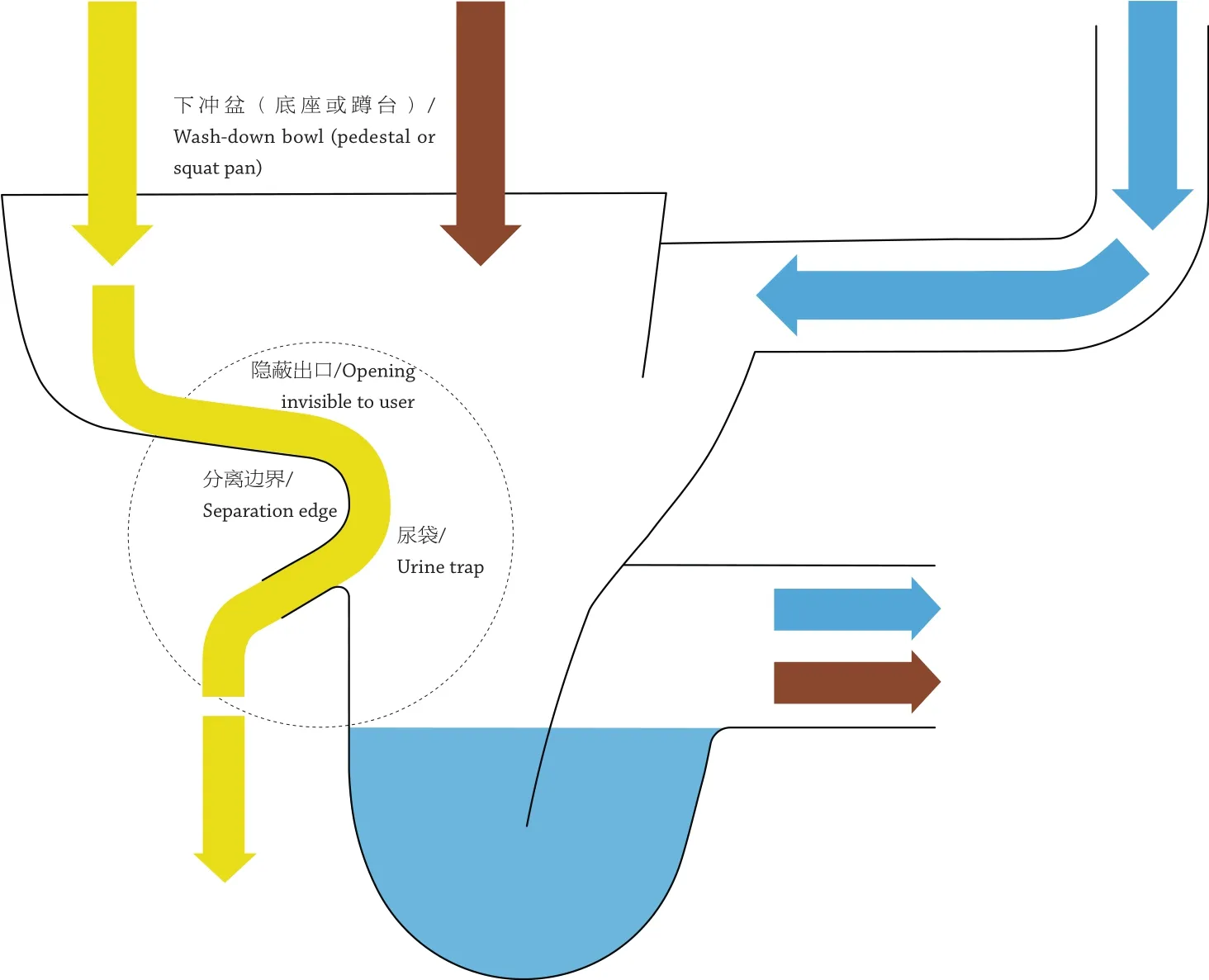厕所革命:现代城市与城市贫民窟中对水污染控制的改善与废水再利用
哈拉尔德·格林德尔,托弗·A·拉森/Harald Gründl, Tove A. Larsen
庞凌波 译/Translated by PANG Lingbo
托弗·A·拉森,瑞士联邦水产科学与技术研究所
为城市贫民窟提供更智能的厕所
在世界各地,有近26亿人口使用不安全的厕所,甚至在开敞的环境中排泄。缺乏适用的卫生设施导致了严重的腹泻,每年有超过160万人因此死亡[1]。健康卫生的设施与手部清洁能够很大程度地降低腹泻的致病几率[2]。然而,通常发展中国家水资源都非常昂贵[3],并且由于水资源的匮乏,洗手的问题经常被忽视。众所周知,改善卫生条件的“千年计划”没有完全实现,但正如鲍姆等人所指出的那样[4],实际情况可能比一般预期的还要糟糕。原因在于“改善卫生条件”的定义只涉及个人的卫生,而忽视了城市卫生的所有方面,其中包括安全的处置或处理厕所废物。城市贫民窟中卫生基础设施缺乏导致厕所污水渗入地下水和灰水流入地表水的现象,同样对环境产生了不利影响。
蓝色分流厕所的故事起始于2011年由比尔及梅琳达·盖茨基金会(BMGF)启动并资助的“厕所创新大赛”项目。来自瑞士联邦水产科学与技术研究所(Eawag)和设计公司EOOS的一个团队是在大赛第一轮获得资金支持的8个团队之一。比赛的目标是为低收入国家的城市贫民窟带来可负担的、可持续的包括洗手功能在内的卫生设施。而比赛规则要求厕所必须回收所有资源,并且可以在不连接任何网络——不论是电网、水网还是排水系统——的情况下运行。另外,该厕所应能够为个人清洁提供水资源,整体的成本应控制在每人每天5美分以下。
对于城市贫民窟地区,修建排水管和污水处理厂成本高昂,遥不可及。在许多情况下,贫民窟都是无基础设施建设的临建区域。我们开发了一个服务规模约为1000人的完整卫生系统,贯穿从收集、储存、运输到资源再利用的整个卫生设施产业价值链。蓝色分流厕所将未稀释的尿液、粪便和受污染的冲水分离,以便有效回收资源。通过多屏障系统(在水冷壁内)处理水质供在地重复利用。我们的概念是以大约1000人的规模从场地之外的尿液和粪便中回收资源,这在当今的技术手段下,显然已具备可行性。
蓝色分流厕所(图1)醒目又易于使用,而且同时适合习惯冲洗和擦拭者使用(冲洗者用水清洁肛门,擦拭者则使用厕纸)。水冷壁可以在任何时候提供安全的自来水,并为大约10个用户(每天50次使用)设计。这款厕所推出了新一代的尿液离心脱水马桶(UDDT),这种马桶通常并不受用户欢迎,特别是对于那些冲洗者而言。蓝色分流厕所有洗手用的水池、个人清洁用的蓬蓬头(用于肛门清洁和经期卫生),以及用于马桶前部的冲水功能。
水冷壁中创新的水循环技术,确保可以获取无病原体的清洁的水。这种在地的水处理仅在马桶的三流分离情况下才可能发生。尿液、粪便与冲洗水互不混合,但仍会有部分粪便和尿液污染废水。不过与抽水马桶相比,这种马桶水污染程度较低,这也是为什么水冷壁可以在现场安全地处理废水并以一种节能的方式回收它。
在地水循环系统是一个不排水的封闭体系,可以防止城市污染与贫民窟积水。由于使用过(比如用湿手碰过)的水必须进行更换,但可以使用少量其他废水或地表水,并在水冷壁中处理。生物处理和超滤膜是水回收技术的重要组成部分。现代城市的大规模饮用水生产依赖于相同的科技,但需通过频繁的、大量消耗能源的反冲洗来去除堵塞细胞膜的生物膜。蓝色分流厕所的超滤膜则不需任何的围护,这得益于家庭饮用水技术的最新发展,即由Eawag开发的所谓的重力驱动膜技术[5]。生活在生物膜与反应器的沉淀物上的高等生物保持着膜的开放,而重力本身就提供了足够的压力来通过膜过滤水。在洁净水箱中,活性炭吸附不可降解的有机物,少量Cl则抑制了微生物的生长。这使得厕所非常节能,因为它没有外部压力,只需要提供O2来降解有机物,而不必保持膜的开放。我们仅需要实现这种简易的水处理,因为分源的措施只会给清洁和冲水带来微量的尿液和粪便。
蓝色分流厕所将从很多方面改善人们的生活。人们将根本上通过安全厕所和触手可及的洗手设施改善个人的清洁卫生。在城市的尺度上,卫生水平也将得到大幅的提升,就地为城市农业提供生产的肥料也能够得以实现。可以想象,当水循环的理念推广至淋浴站和洗衣房,对人们的生活产生强烈影响的同时,也会减少带来的蚊子滋生风险的积水,城市环境也将得以改善。
我们在乌干达坎帕拉测试了第一个蓝色分流厕所的工作模型。在为期3周的时间内,人们可以在一个临建区域的社区卫生中心使用厕所。
随后,两个擦拭者家庭,以及两个冲洗者家庭共享了这个厕所,就像“现实生活”中的情况一样。总体下来,据托拜厄斯等人的报道,我们共进行了1500次采访[6]。
大多数人对厕所的评价都是正面的,对可洗手、清洁与冲水功能的反馈最为正面。也有一些批判性的观点,导致了在肯尼亚第二次实验之前对厕所进行的改造。最重要的变化在于尺寸的缩小,以便更好地契合现有厕所的上部构造,并以电动泵代替脚踏泵——许多人担心小孩与老人可能没有力气使用脚踏泵。第二次改进厕所的实地测试是在肯尼亚内罗毕进行的。人们对厕所给出了正面的评价:100%的人特别喜欢厕所的外观,95%的人认为它使用方便,大约94%的受访者会将它推荐给家人和朋友。
蓝色分流厕所目前仅作为一种原型存在,它尚未投入市场。其中最难点在于找到相信这一系统的工业合作伙伴。我们建立了一种商业模式,以租用
Smarter toilets for urban slums
Worldwide, almost 2.6 billion people use unsafe toilets or even defecate in the open. Lack of proper sanitation causes severe diarrhea, killing more than 1.6 million people every year[1]. Hygienic sanitation and hand washing can reduce the occurrence of diarrhea significantly[2]. Water is generally expensive in developing countries[3]and with little water available, hand washing is often neglected. It is wellknown that the millennium development goals for improved sanitation was not realised, but as pointed out by Baum et al.[4]the situation may in reality be even worse than normally anticipated. The reason is that "improved sanitation" is defined only with respect to personal hygiene, while neglecting all aspects of urban hygiene, including safe disposal or treatment of toilet waste. Lack of sanitation infrastructure in urban slums also lead to detrimental environmental effects, primarily through infiltration of latrine effluent to groundwater and run-ffi of greywater to surface water.
The story of the Blue Diversion Toilet began in 2011 with the Bill & Melinda Gates Foundation(BMGF) initiating and funding the "Reinvent the Toilet Challenge" (RTTC). A team from Eawag (the Swiss Federal Institute of Aquatic Science and Technology) together with the design company EOOS was among the eight groups receiving a grant in the first round of the RTTC. The goal was to bring affordable and sustainable sanitation including hand washing to urban slums in low-income countries. The rules of the competition were that the toilet had to recover all resources and operate without connection to any grids, be it an electricity grid, a water supply grid, or a sewer system. Furthermore, the toilet should provide water for personal hygiene, and total costs should be below 5 US cents per person and day.
Building sewers and treatment plants is expensive and out of reach for urban slums, which are in many cases informal settlements where cities have no interest in installing infrastructure.We developed a holistic sanitation system at the scale of around 1000 people that works across the entire sanitation value chain from capture, storage and transport to reuse of resources. The Blue Diversion Toilet separates undiluted urine, feces and contaminated flush-and-wash water in order to allow for efficient resource recovery. A multi-barrier system(in the Water Wall) treats the water for on-site reuse.The idea is to recover the resources from urine and feces ffi-site at a scale of around 1000 persons. This is clearly feasible with today's technology.
The Blue Diversion Toilet (Fig. 1) is attractive and easy to use, and suitable for both washers and wipers (washers use water for anal cleansing; wipers use toilet paper). The Water Wall provides safe running water at all times and is designed for around 10 users (50 uses per day). The toilet presents a nextgeneration version of the urine diverting dehydrating toilet (UDDT), which is usually not very popular among users, especially not amongst washers. The Blue Diversion Toilet has a washbasin for hand washing, a showerhead for personal hygiene (for anal cleansing and menstrual hygiene), and a flush function for the front part of the toilet.
The innovative water recovery technology in the water wall ensures the availability of pathogenfree, clean water. This on-site water treatment is only possible due to the three-stream separation in the toilet pan. Urine, feces and the flush and wash water do not mix, but some fecal matter and some urine still contaminate the wastewater. However, compared to a flush toilet, the contamination of the water is very low. This is why the water wall can treat the water safely on-site and recycle it in an energy-efficient way.
The on-site water recovery system is a closed system without water discharge, preventing urban pollution and stagnant water in the slum. The water removed through usage (e.g., by wet hands) must be replaced, but small amounts of other wastewaters or surface water can be used and treated within the Water Wall. Biological treatment and the ultrafiltration membrane is the most important part of the water recovery technology. Large-scale drinking water treatment in modern cities relies on the same technology, but in a form that requires frequent and energy-intensive back-flushing to remove the biofilm that clogs the membrane. The ultrafiltration membrane in the Blue Diversion Toilet does not need any maintenance thanks to a recent development in household drinking water technology, the so-called gravity-driven membrane technology developed at Eawag[5]. Higher organisms living on the biofilm and the sludge in the reactor keep the membrane open and gravity alone supplies enough pressure to filter the water through the membrane. In the clean water tank, activated carbon adsorbs the non-degradable organic matter, and a small amount of chlorine prevents microbial growth.This makes the toilet extremely energy-efficient because it works without external pressure and only has to provide oxygen for degradation of organic matter and not for keeping the membrane open.We can only achieve such easy treatment because of source separation that only allows for traces of urine and feces to enter the wash and flush water.
The Blue Diversion Toilet would improve people's life in many aspects. People would primarily be able to improve their own personal hygiene through a safe toilet with access to hand washing.On an urban scale, hygiene would also be highly improved and a local fertiliser for urban agriculture would be available. It is very well conceivable that the idea of the water recycling could be extended to showers and laundry stations, with strong impact on people's daily life and an improved urban environment with less stagnant water leading to risks of mosquito breeding.
We tested the first working model of the Blue Diversion Toilet in Kampala, Uganda. During three weeks, people were able to use the toilet in a community sanitation centre in an informal settlement.
Afterwards, first two families of wipers, then two families of washers shared the toilet, as would be the case in "real-life". Overall, we were able to conduct 1500 interviews, as reported by Tobias et al[6].
Most people evaluated the toilet positively, with most positive responses on the availability of water for hand washing, anal cleansing and flushing. There were also critical points, resulting in a remodeling of the toilet before the second trial in Kenya. The most important changes was a decrease of size to allow for a better fit in existing toilet superstructures and the use of an electric pump instead of a foot pump.Many people were afraid that children and elderly would not have the strength to use the foot pump.The second field test with the improved toilet took place in Nairobi, Kenya. People evaluated the toilet positively. They especially liked how the toilet looks(100%) and that it is easy to use (95%). Around 94%of the people interviewed would recommend it to family and friends.
The Blue Diversion toilet only exists on the level of a prototype; it is not market-ready yet. The most difficult issue is to find industrial partners that believe in the system. We have set up a business model based on renting of the toilet and paying on a weekly basis for the necessary transport services. We anticipate a franchising model where a local business get the license to set up the system in a given area. Although the single systems can function on a small scale, only massproduction can make the toilets and the treatment technology cheap enough to secure the low cost service that slum dwellers can afford. This is a major endeavor and it is understandable that industries are hesitant to take on this task. As one stepping-stone, we work on the separate industrialisation of the water wall, which is considerably simpler to produce than the entire system.厕所和每周为必要的运输服务付费为基础。我们预计这将成为一种特许经营模式,在这种模式下,当地企业获得许可证,便可以在特定地区建立该系统。尽管单个厕所系统可以在小范围内产生作用,但只有大规模的生产,才能够使厕所和水处理技术足够便宜到保证贫民窟的居民能够负担这种低成本服务。这是一项重大举措,可以理解行业在采取行动时的犹豫不决。作为一块敲门砖,我们正致力于水冷壁的分离产业化——这比整个系统的生产要简单得多。

1 蓝色分流厕所/Blue Diversion Toilet (图片来源/Source: ©Eawag/EOOS)

2.3 Laufen公司产品“Save!”/Laufen save!(图片来源/Sources: ©Laufen)

4 “尿袋”设计/Scheme "Urine Trap"(图片来源/Source: ©EOOS)
为更智慧的城市提供更智能的卫生设施
如果这是一种极其有效的保护环境的方法——比建造排污管道和最终的污水处理厂要更有效,那么就把排泄物保存并转化为有益如化肥的产品。同样的,现场处理和回收水提供了最大限度的地表水保护及水的再利用。
更便捷的处理废水的关键在于尿液分离。尿液包含人体新陈代谢所产生的大部分营养物质,正是这些营养物质使废水处理变得困难且昂贵[7]。移除粪便则要容易得多,通过沉淀和简单的生物处理即可。这一点不仅在城市贫民窟中成立,在世界各地的现代城市中也同样适用。这就是为何许多废水研究员对尿液分离感兴趣,在像巴黎和香港这样的现代城市也是如此[8-9]。有许多技术用于尿液分离,或是用于养分分离,或是用于养分回收[10]。其中尤其成功并已准备工业化的是“Vunatechnology”1)。一度阻碍这种技术实施的是一种具有吸引力的尿液分离冲水马桶。
已准备上市的尿液分离马桶“Save!”(图2、3)消除了这个阻碍。这款马桶由奥地利设计公司EOOS设计,将由瑞士大型卫生设备公司LAUFEN生产。这款马桶将会在2020年初在欧洲上市。
“Save!”是首个符合现代工业标准的尿液分离冲水马桶。它能被动地将尿液从固体和冲水中分离出来。这款产品的关键创新点在于由EOOS设计公司所发明的“尿袋”,它可以仅仅依靠表面张力将尿液越过马桶的水面导向一个隐蔽出口(图4)。这就是著名的“茶壶效应”。LAUFEN将这个概念运用于到一种新型的马桶上,这种马桶形式上近似一个陶瓷碗,智能的形式可以引导水流、优化“Save!”的性能。这种表面适用于所有的马桶类型,而隐藏其中的发明确保它与任何其他高档马桶别无二致。这种颠覆性的设计代表了习以为常的产品的一种新形式,可以在可持续的污水处理的未来里起到关键作用。
在中国特定的背景下,“Save!”的巨大优势体现在集中式和分散式水回用的更好适用性。特别是在世界上最缺水的城市之一——北京,对水的需求的不断增加呼吁着水循环技术的创新[11]。在2014年地表水和再生水几乎占到供水总量的一半的情况下,如果能简化废水处理,不必进行养分去除,将是非常有助益的。鉴于北京是小型水循环技术产品的国际中心[12],那将意味着,如果尿液分离成为标准,当地工业将会在中国乃至全球范围内其他缺水地区获得巨大的利润。□
Smarter sanitation for smarter cities
Containing excreta and transforming it to beneficial products like fertiliser if an extremely effective way of protecting the environment - much more effective than building sewers and - eventually - treatment plants.In the same way, treating and recycling water on-site provides maximal surface water protection and water reuse.
The key to easier treatment of wastewater is urine separation. Urine contains most of the nutrients from the human metabolism and it is the nutrients that makes wastewater treatment difficult and expensive[7]. Feces are much more easily removed by sedimentation and simple biological treatment. This is not only true in urban slums, but also in modern cities all over the world. This is why many wastewater researchers are interested in urine separation, also in modern cities like Paris and Hong Kong[8-9]. Many technologies exist for the separate treatment of urine, either for nutrient removal or nutrient recovery[10]. Especially successful and ready for industrialisation is the "Vuna-technology"1). The main hurdle for implementation has been the absence of an attractive flush toilet with urine separation.
The development of the market-ready urineseparating toilet Save! (Fig. 2, 3) removes this hurdle. The toilet was designed by EOOS, an Austrian design ffiice, and will be produced by LAUFEN, a major Swiss sanitation company. The toilet will be on the market in Europe by early 2020.
Save! is the first urine-diverting flush toilet to meet modern industry standards of conventional toilets. It passively separates urine from solids and flush water. The product's key innovation is a "Urine Trap" (www.urinetrap.com) invented by EOOS Design, which directs urine across the toilet's surface towards a concealed outlet using only surface tension (Fig. 4). This is known as the "teapot effect". Laufen applied this concept to a new form of toilet featuring a ceramic bowl that is intelligently shaped to guide the water flow and optimise the performance of Save! The interface is universally applicable to all toilet typologies and the hidden innovation ensures it is indistinguishable from any other high-end toilets. This disruptive design represents a new format for a familiar product that could play a key role in the future of sustainable wastewater management.
The large advantage of Save! in a specific Chinese context is the better applicability of centralised and decentralised water reuse. Especially in the Region of Beijing, one of the most waterscarce cities in the world, the increased demand for water calls for innovations in water recycling technology[11]. With surface water and reclaimed water accounting for nearly half of the water supply in 2014, simplified wastewater treatment without nutrient elimination would be extremely beneficial. Since Beijing is an international centre for the production of small-scale water recycling technologies[12], the local industry would profit immensely if urine separation would become standard, not only in China, but also in other waterscarce regions globally. □
注释/Note
1)经过多年的研究,Eawag已经能够开发出一种用尿液生产安全浓缩肥料的方法[13]。生物处理能够稳定尿液,并去除有机物和意味。经过生物处理后,活性炭柱出去通过尿液排出的剩余药物和激素。随后的蒸馏浓缩尿液,以生产一种具有吸引力的浓缩肥料,名叫Aurin。严格的瑞士当局为所有作用提供了肥料补贴,因为Aurin使用绝对安全,而且可以用于所有可食用的作物。/The Vuna technology: Based on many years of research, Eawag has been able to develop a method for the production of a safe concentrated fertiliser from urine[13].Biological treatment stabilises urine and removes the organic matter and the smell. After biological treatment, an activated carbon column remove the remaining pharmaceuticals and hormones excreted via urine. The following distillation concentrates the urine to produce an attractive concentrated fertilizer with the name Aurin. The strict Swiss authorities have provided a fertilizer allowance for all crops, because Aurin is absolutely safe to use, also for all edible crops.For more information, see: https://www.eawag.ch/en/department/eng/projects/aurin-fertilisers-from-urine/

